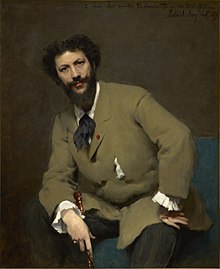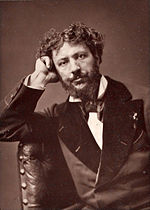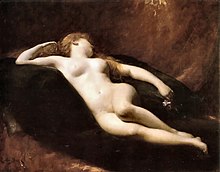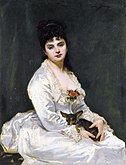| Carolus-Duran | |
|---|---|
 Portrait of Carolus-Duran (1879), Clark Art Institute, by John Singer Sargent. Portrait of Carolus-Duran (1879), Clark Art Institute, by John Singer Sargent. | |
| Born | Charles Auguste Émile Durand (1837-07-04)4 July 1837 Lille, France |
| Died | 17 February 1917(1917-02-17) (aged 79) Paris, France |
| Nationality | French |
| Alma mater | Académie des Beaux-Arts |
| Known for | director of the French Academy in Rome |
| Spouse |
Pauline Croizette [fr]
(m. 1869; died 1912) |
| Children | 3 |
| Awards | Grand Officer, Legion of Honour (1900) |
| Signature | |
 | |
Charles Auguste Émile Durand, known as Carolus-Duran (4 July 1837 in Lille – 17 February 1917 in Paris), was a French painter and art instructor. He is noted for his stylish depictions of members of high society in Third Republic France.
Biography
The son of a hotel owner, his first drawing lessons were with a local sculptor named Augustin-Phidias Cadet de Beaupré (1800–?) at the Académie de Lille; then took up painting with François Souchon, a student of Jacques-Louis David. He went to Paris in 1853, where he adopted the name "Carolus-Duran".
In 1859, he had his first exhibition at the Salon. That same year, he began attending the Académie Suisse, where he studied until 1861. One of his early influences was the Realism of Gustave Courbet.

From 1862 to 1866, he travelled to Rome and Spain, thanks to a scholarship granted by his hometown. During that time, he moved away from Courbet's style and became more interested in Diego Velázquez.
Upon returning to France, he was awarded his first gold medal at the Salon. His picture "Murdered", or "The Assassination" (1866), was one of his first successes, but he became best known afterwards as a portrait-painter, and as the head of one of the principal ateliers in Paris, where some of the most brilliant artists of a later generation were his pupils.
In 1867, he became one of the nine members of the "Société Japonaise du Jinglar" (a type of wine); a group that included Henri Fantin-Latour, Félix Bracquemond and Marc-Louis Solon. They would meet once a month in Sèvres for a dinner "à la Japonaise".
He married Pauline Croizette [fr], a pastellist and miniaturist who had posed for his painting "The Lady in Gloves" in 1869. They had three children. Their eldest daughter, Marie-Anne, married the playwright Georges Feydeau.

After 1870, he devoted himself almost entirely to portraits. While many of his paintings depicted wealthy patrons in elegant clothing, he also notably painted a portrait of his gardener which stands in contrast to his other works in its loose strokes and earth tones. His success allowed him to open a studio on the Boulevard du Montparnasse, where he also gave painting lessons. He was named a Knight in the Légion d'honneur in 1872; being promoted to Officer in 1878, Commander in 1889 and Grand Officer in 1900.
In 1889 and 1900 he served on the juries at the Expositions Universelles. In 1890, he was one of the co-founders of the second Société Nationale des Beaux-Arts and he was elected a member of the Académie des Beaux-Arts in 1904. The following year, he was appointed Director of the French Academy in Rome, a position he held until 1913.

He was a frequent visitor to the resort at Fréjus, where he owned a small villa. Following his death at age 79, the resort named a plaza and a beach after him.
Pupils
His pupils reportedly included John Singer Sargent, Irving Ramsey Wiles, Ralph Wormeley Curtis, Francis Brooks Chadwick, Emma Chadwick Jan Stanisławski (painter), Kenyon Cox Theodore Robinson, Mariquita Jenny Moberly. Mariette Leslie Cotton, Maximilien Luce, James Carroll Beckwith, Will Hicok Low, Mary Fairchild MacMonnies Low, Alexandre Jean-Baptiste Brun, Robert Alan Mowbray Stevenson, Lucy Lee-Robbins, Ramón Casas i Carbó, Ernest Ange Duez and James Cadenhead

Selected works
Further information: List of works by Carolus-Duran-
 Madame Henry Fouquier
Madame Henry Fouquier
(1876) -
 Édouard Manet (1880)
Édouard Manet (1880)
-
 Anna Gould
Anna Gould
-
 Natalie Clifford Barney
Natalie Clifford Barney
at age ten (ca. 1886–1887) -
The Artist's Daughter,
Marie-Anne (1874) -
 Marie-Anne as Madame Feydeau (1897)
Marie-Anne as Madame Feydeau (1897)
-
 Georges Feydeau
Georges Feydeau
(ca. 1900) -
 Portrait of Emily Warren Roebling (ca. 1896), Brooklyn Museum
Portrait of Emily Warren Roebling (ca. 1896), Brooklyn Museum
-
 Merrymakers
Merrymakers
(1870) -
 Le Baiser (The Kiss)
Le Baiser (The Kiss)
(1868) Self-portrait with his wife as newlyweds. -
 Mademoiselle de Lancey
Mademoiselle de Lancey
-
Equestrian Portrait of Mademoiselle Croizette (1873)
-
 The Poet with the Mandolin (1887)
The Poet with the Mandolin (1887)
-
 Maria Pia of Savoy, Queen of Portugal (1883)
Maria Pia of Savoy, Queen of Portugal (1883)
References
- ^ Chisholm 1911.
- Profile, iment.com. Accessed 17 February 2024.
- Profile, Britannica.com. Accessed 17 February 2024.
- (in Spanish)Museo del Prado, museodelprado.es. Accessed 17 February 2024.
- Un artiste à réévaluer : Carolus-Duran , "Art Nouveau et Jugendstil. Courants artistiques et littéraires de 1880 à 1920", April 2012.
- "The Lady with the Glove", Musee-orsay.fr. Accessed 17 February 2024.
- "The Artist's Gardener". clarkart.edu. Retrieved 14 June 2023.
- Profile, ArtHermitage.org. Accessed 17 February 2024.
- Smithsonian American Art Museum
- Trevor Fairbrother, John Singer Sargent, New York: Harry N. Abrams, 1994, p. 13; ISBN 0-8109-3833-2
- Ann Lee Morgan, The Oxford Dictionary of American Art and Artists
- "Biography: Theodore Robinson, 1852–1896". National Gallery of Art (Washington, D.C.). Retrieved October 23, 2013.
- "Best Friends". Leighton Fine Art. Archived from the original on 29 October 2013. Retrieved 13 May 2013.
- Florence Nightingale Levy (1910). American Art Directory. R.R. Bowker. p. 112.
- "Inventaire du fonds français après 1800". Archived from the original on 16 November 2016.
- "Lee Robbins, Lucy". Oxford index. Oxford University Press. 31 October 2011. Archived from the original on 10 November 2019. Retrieved 17 September 2018.
- Mowat, Alison (Ed.) (2013), James Cadenhead RSA RSW 1858 - 1927: His Letters Home as a Young Man, Alison Mowat, pp. 98-100
Attribution:
 This article incorporates text from a publication now in the public domain: Chisholm, Hugh, ed. (1911). "Carolus-Duran". Encyclopædia Britannica. Vol. 5 (11th ed.). Cambridge University Press. p. 381.
This article incorporates text from a publication now in the public domain: Chisholm, Hugh, ed. (1911). "Carolus-Duran". Encyclopædia Britannica. Vol. 5 (11th ed.). Cambridge University Press. p. 381.
External links
- Paintings of Carolus-Duran on Insecula
- Works by Carolus-Duran at Project Gutenberg
- Carolus Duran at the Internet Speculative Fiction Database
- Carolus-Duran in American public collections, on the French Sculpture Census website

| Georges Feydeau | |
|---|---|
| Plays |
|
| Adaptations |
|
| Related people | |
- 1837 births
- 1917 deaths
- 19th-century French painters
- 20th-century French male artists
- 20th-century French painters
- French male painters
- French portrait painters
- Grand Cross of the Legion of Honour
- Members of the Académie des beaux-arts
- Members of the Ligue de la patrie française
- Artists from Lille
- 19th-century French male artists